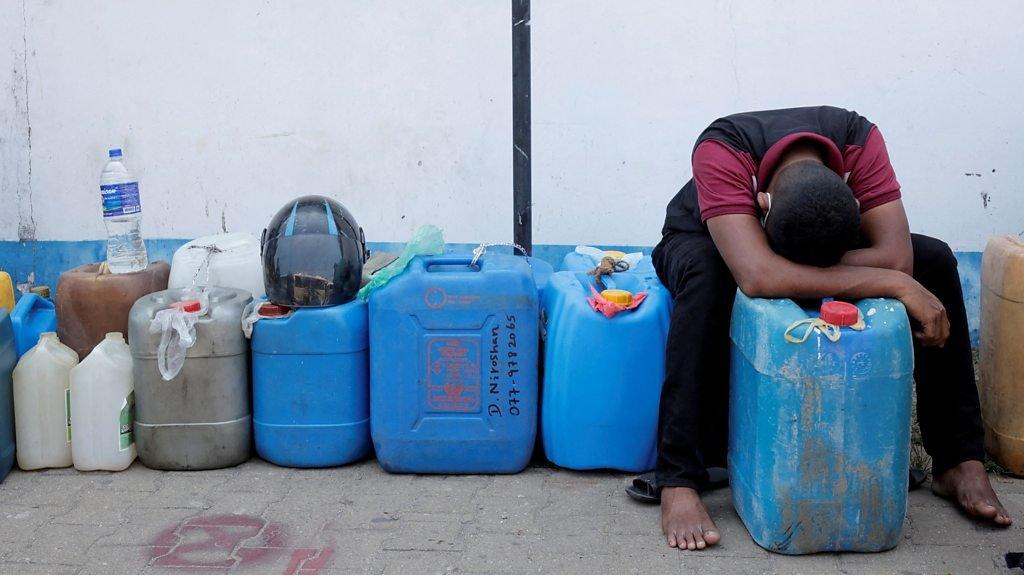Sri Lanka: The divisions behind the country's united protests
- Published
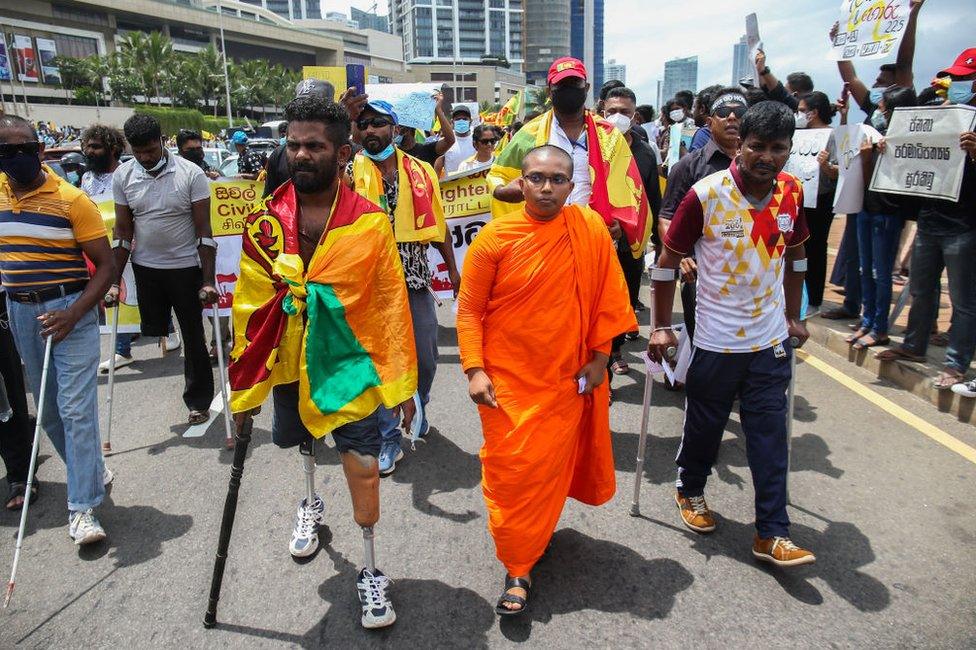
Colombo has seen huge anti-government protests in recent weeks
"Look: the Muslims are here, the Hindus are here, the Catholics are here. All the same blood.
"This is the real Sri Lanka."
Lukshan Wattuhewa gestures across Galle Face Green on Colombo's colourful seafront, where thousands of demonstrators now converge daily.
He hopes massive anti-government protests - fuelled by the country's worst ever economic crisis - can mark a turning point in the decades of ethnic and religious violence that have scarred so many communities across Sri Lanka.
A Buddhist monk nearby agrees: "People are putting aside religious and racial differences to join this struggle. Sri Lanka has become one united nation."
Both men are from the Sinhala Buddhist majority, who account for three-quarters of Sri Lanka's diverse population. Tamil Hindus, Muslims and Christians are among the country's sizeable minorities.
For weeks now, citizens have been taking to the streets across Sri Lanka with a simple message: "Gota go home".
"Gota" is Gotabaya Rajapaksa, the country's president, who swept to election victory on a Sinhala nationalist platform months after the deadly Easter Day bombings, which were carried out by an Islamist group in 2019.
But now his support has plummeted. Economic hardship has pushed many of those who voted for him to demand his resignation. Aside from economic mismanagement, much of his presidency has been defined by accusations of racism.
Critics say he successfully fanned the country's longstanding ethnic and religious tensions for political gain. At his inauguration Mr Rajapaksa himself said: "I knew I could win this presidency through Sinhalese votes alone."
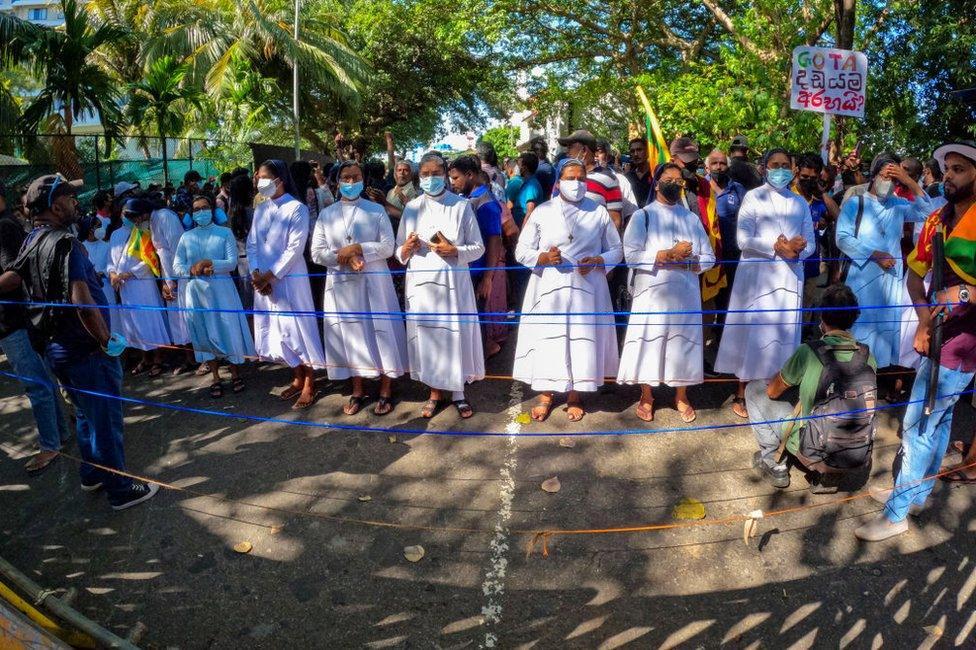
The protests in Colombo have presented a show of unity across religions and ethnicities
The politics of Sinhalese supremacy is not new in Sri Lanka, with Tamils being the most targeted community historically. Gotabaya Rajapaksa was Sri Lanka's defence secretary in 2009 when the government put a brutal end to a decades-long civil war with the separatist LTTE or Tamil Tigers.
Many in the Sinhalese population hailed him as a hero at the time but there have also been calls to hold him accountable for human rights abuses carried out during the war.
Critics say that instead of then reaching out to the Tamil community, the Rajapaksas continued to pursue a populist majoritarian agenda that made Tamils feel like second-class citizens.
But since the Easter Day bombings and Rajapaksa's election, Muslims too have increasingly faced vilification.
"We've seen mass scale violence targeting Muslims' houses, livelihoods and our basic right to exist with dignity," says Shreen Saroor, a prominent Muslim rights activist.
Apart from mob attacks and boycotts of Muslim businesses from Sinhala Buddhists, she says the government's pandemic policy of forcibly cremating bodies - which is forbidden in Islam - "laid bare institutionalised anti-Muslim traits".
This is why, for many who support the protests, the interracial solidarity on display at Galle Face Green in Colombo is a direct rebuke of President Rajapaksa's divisive policies. But analysts warn that this is just one perspective.
"This is certainly a unique moment," says Bhavani Fonseka, a senior researcher at the Centre for Policy Alternatives in Colombo.
"But how that translates into real progress remains to be seen. There is definitely a sense of suspicion among minorities to see so many of those who used to be champions of this government now protesting against it."
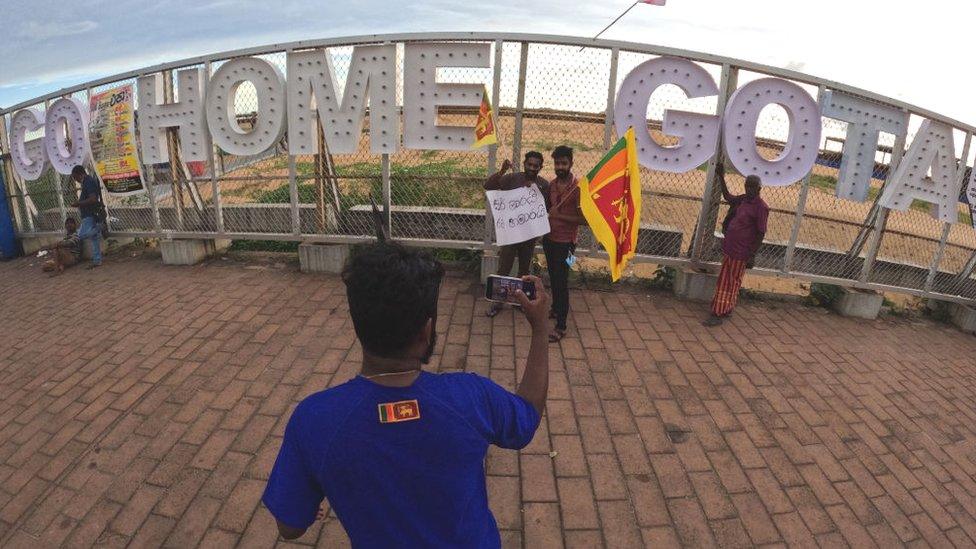
Protesters have been demanding the resignation of President Gotabaya Rajapaksa
While the protests in the cosmopolitan capital are peaceful and carnival-like, the situation is different in the north and east of the country, where most of Sri Lanka's Tamil population resides.
Protests in these areas have so far been much rarer, even though anti-government sentiment historically runs deep.
Tamil activists say they fear security forces will not exhibit the same kind of restraint that has been afforded to protesters in Colombo.
"Here, organising demonstrations has always been met with state violence," says Anushani Alagarajah, a Tamil civil rights activist based in Jaffna in northern Sri Lanka. "There are always two different treatments of protesters. It depends on who you are and where you are."
So far the only protest-related death has been in Rambukkana, a small rural town in central Sri Lanka.
Police opened fire into a crowd with live bullets, injuring 14 people and killing a Sinhala Buddhist man.
Alagarajah says a tragic incident such as this could have an enlightening effect on the country's majority community given it's the minorities who have faced crackdowns for decades.
But she feels let down over the fact that after years of protest by her own community, it's demonstrations involving the Sinhala majority that have attracted international media attention.
Many Tamils are still missing or unaccounted for since the end of the civil war, but successive Sri Lankan governments have tried to block international efforts to investigate alleged war crimes.
Memorial events for Tamil fighters are regularly prohibited, often by force, and local politicians have been detained, including the Mayor of Jaffna last year. There are also frequent allegations of brutality carried out by the police, who still maintain a high security presence in the north.
"Can we feel safe in this protest space if we start talking about justice and accountability?" says Alagarajah.
One example she cites is the destruction of a Hindu shrine and temple in the north-east of the country, which were replaced by Buddhist symbols and flags.
Hindu worshippers who continued to visit the site were not only monitored by Sri Lankan intelligence personnel, but also allegedly racially abused by monks.
"You see Buddhist monks in Colombo protesting for change, but just the other day here in the north it was monks who were blocking devotees from visiting a Hindu temple, external," Alagarajah says.
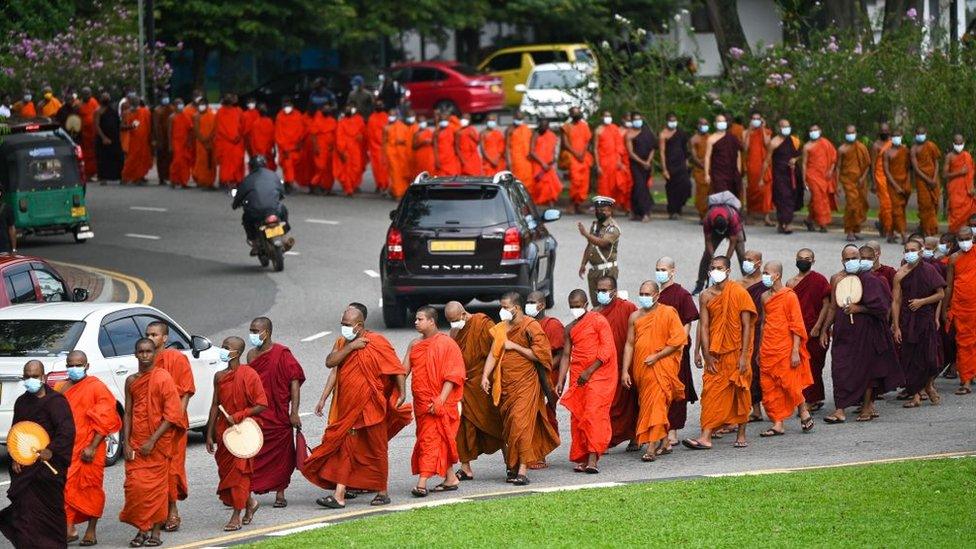
Sri Lanka's Buddhist monks have shown their support for the demonstrations
Back at Galle Face Green, a line of monks is marching outside the Presidential Secretariat. They are followed by a procession of Catholic nuns in another show of interfaith unity.
Amalini De Sayrah - one of many coordinators in a largely leaderless protest movement - says that while moments like this are "beautiful to see", there is much more work to do, especially by her own Sinhala community.
"It's great that we've been able to celebrate the Sinhala and Tamil New Years together. We've also had giant Iftars [breaking of the fast] with Muslim protesters here on this lawn together.
"If there was a moment to bring about real, meaningful and long-lasting unity, this would be it. I just hope that in this post-Rajapaksa world that we're all hoping for, Tamils and Muslims won't be relegated back to the kind of second-class citizens that they have always been."
Luckshan Wattuhewa, the protester on the seafront, says that most people right now have the same basic needs: they are focused on securing enough food, fuel and medicine for their families.
But, a scriptwriter by profession, he is hoping for a new chapter in his country's history.
"We had 30 years of war and we suffered a lot. Enough now - we want a peaceful country."
- Published8 April 2022
